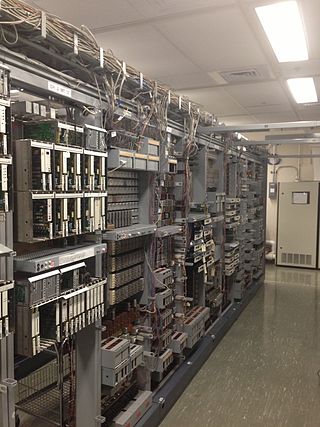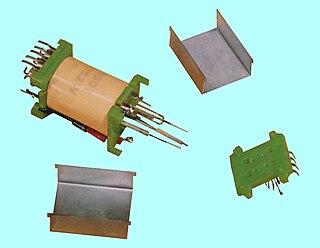Related Research Articles

The 5ESS Switching System is a Class 5 telephone electronic switching system developed by Western Electric for the American Telephone and Telegraph Company (AT&T) and the Bell System in the United States. It came into service in 1982 and the last unit was produced in 2003.
In telecommunications, an electronic switching system (ESS) is a telephone switch that uses solid-state electronics, such as digital electronics and computerized common control, to interconnect telephone circuits for the purpose of establishing telephone calls.

In electronics and telecommunications, a crossbar switch is a collection of switches arranged in a matrix configuration. A crossbar switch has multiple input and output lines that form a crossed pattern of interconnecting lines between which a connection may be established by closing a switch located at each intersection, the elements of the matrix. Originally, a crossbar switch consisted literally of crossing metal bars that provided the input and output paths. Later implementations achieved the same switching topology in solid-state electronics. The crossbar switch is one of the principal telephone exchange architectures, together with a rotary switch, memory switch, and a crossover switch.
Call waiting is a telephone service where a subscriber can accept a second incoming telephone call by placing an in-progress call on hold—and may also switch between calls. With some providers it can be combined with additional features such as conferencing, call forwarding, and caller ID. Call waiting is intended to alleviate the need to have more than one telephone line or number for voice communications.
Bell-Northern Research (BNR) was a telecommunications research and development company established In 1971 when Bell Canada and Northern Electric combined their R&D organizations. It was jointly owned by Bell Canada and Northern Telecom. BNR was absorbed into Nortel Networks when that company changed its name from Northern Telecom in the mid-1990s.

The DMS-100 is a member of the Digital Multiplex System (DMS) product line of telephone exchange switches manufactured by Northern Telecom. Designed during the 1970s and released in 1979, it can control 100,000 telephone lines.

The AXE telephone exchange is a product line of circuit switched digital telephone exchanges manufactured by Ericsson, a Swedish telecom company. It was developed in 1974 by Ellemtel, a research and development subsidiary of Ericsson and Televerket. The first system was deployed in 1976. AXE is not an acronym, but an Ericsson product code.
SP-1 was the name of a computerized telephone exchange manufactured by Northern Electric in Canada. It was introduced in 1971
A class-5 telephone switch is a telephone exchange in the public switched telephone network (PSTN) that directly serves subscribers and manages subscriber calling features. Class-5 services include basic dial-tone, calling features, and additional digital and data services to subscribers connected to a local loop.

A marker is a type of special purpose control system that was used in electromechanical telephone central office switches. Switches employing markers belong to a class of switches known as "common control", as the purpose of a marker is to control the closure of contacts in the switching fabric that connect a circuit between the calling party and the called party. This is in contrast to "direct control" switches, where the switching elements were controlled directly by the customer's dial, such as the Step by Step switch. The term marker came from its use to mark a path of links through the switching fabric. A marker's comprehensive view of the switching fabric allowed it to find and assemble a path from one terminal to another, if the links were available, unlike the earlier graded progressive systems in which a path might not be found.
Automatic message accounting (AMA) provides detailed accounting for telephone calls. When direct distance dialing (DDD) was introduced in the US, message registers no longer sufficed for dialed telephone calls. The need to record the time and phone number of each long-distance call was met by electromechanical data processing equipment.
The following outline is provided as an overview of and topical guide to automation:

The Number One Electronic Switching System (1ESS) was the first large-scale stored program control (SPC) telephone exchange or electronic switching system in the Bell System. It was manufactured by Western Electric and first placed into service in Succasunna, New Jersey, in May 1965. The switching fabric was composed of a reed relay matrix controlled by wire spring relays which in turn were controlled by a central processing unit (CPU).

TXE, was a family of telephone exchanges developed by the British General Post Office (GPO), designed to replace the ageing Strowger switches.
The GTD-5 EAX is the Class 5 telephone switch developed by GTE Automatic Electric Laboratories. This digital central office telephone circuit switching system is used in the former GTE service areas and by many smaller telecommunications service providers.
The No. 4 Electronic Switching System (4ESS) is a class 4 telephone electronic switching system that was the first digital electronic toll switch introduced by Western Electric for long-distance switching. It was introduced in Chicago in January 1976, to replace the 4A crossbar switch. The last of the 145 systems in the AT&T network was installed in 1999 in Atlanta. Approximately half of the switches were manufactured in Lisle, Illinois, and the other half in Oklahoma City, Oklahoma. At the time of the Bell System divestiture, most of the 4ESS switches became assets of AT&T as part of the long-distance network, while others remained in the RBOC networks. Over 140 4ESS switches remained in service in the United States in 2007.

The Highgate Wood telephone exchange was the first all-electronic telephone exchange in Britain. It was built in the London suburb of Highgate by members from Joint Electronic Research Council (JERC).

A telephone exchange, telephone switch, or central office is a telecommunications system used in the public switched telephone network (PSTN) or in large enterprises. It interconnects telephone subscriber lines or virtual circuits of digital systems to establish telephone calls between subscribers.
The T200 telex switching system produced by Hasler Ltd of Berne broke new ground in the modernization and spread of Telex. During the 1970s and 1980s it pioneered the introduction of digital equipment and the deployment of Stored Program Controlled (SPC) Exchanges, gradually replacing the former electromechanical telex networks.
References
- ↑ Alpha Doggs (2008-02-15). "Phone switching pioneers to be inducted in National Inventors Hall of Fame". Network World. Retrieved 2012-06-17.
- ↑ "Erna Schneider Hoover". Maximumpc.com. 2012-06-17. Retrieved 2012-06-17.
- ↑ "Erna Schneider Hoover". Global History Network of IEEE. 2012. Retrieved 2012-06-17.
- ↑ Joel, A. E. (October 1958). "An Experimental Electronic Switching System". Bell Laboratories Record. 36 (10): 359.
- ↑ Thiagarajan., Viswanathan (1992). Telecommunication switching systems and networks. New Delhi: Prentice Hall of India Private Ltd. ISBN 0876927134. OCLC 29022605.